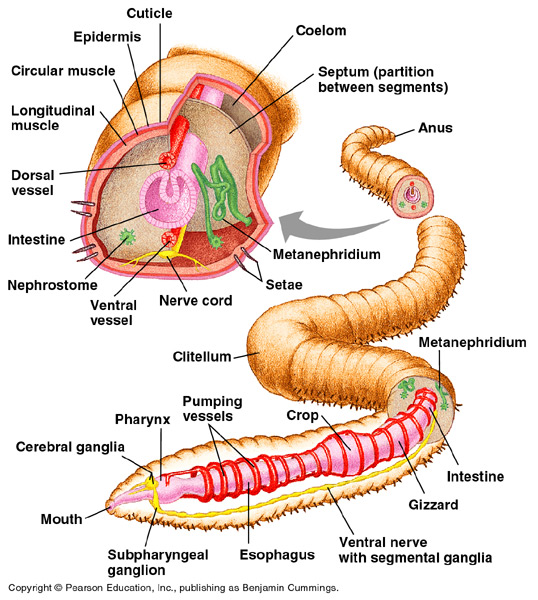I know I've already written about worms, but she's rather fond of worms so we talk about them a lot. We also pick them up, talk to them, pet them and rescue them. We do this with potato bugs too (and they had breakfast with us once) but that's a whole other story.
The following picture should take some of us back to Grade 11 science class (or was it grade 10? or 12? It was a long time ago in the olden days of plaid and army boots) where we dissected formaldehyde soaked earthworms. I think this was one of my first inklings of my future career choices as I thoroughly enjoyed taking apart the worms and in fact did several, helping out my more squeamish classmates. I ended up taking several physiology classes in university where I took apart a variety of dead vertebrates and invertebrates and my first biology job was in an avian energetics lab where I dissected birds for 8 hours a day. If anyone needs a bird separated into all it's individual parts - I'm your girl!
But this isn't about how cool the insides of animals are (and I fear I may be making myself sound rather macabre) this is about worms. So here's a worm's insides:
 |
| Betcha didn't know worms were so complicated! http://www.sas.upenn.edu/~rlenet/EarthwormAnatomy1.jpg |
So worms have a lot of things! Notice anything they don't have? Eyes, ears and nose. That's 3 of the 5 senses missing - so they have to get by on touch and taste.
But they do have a mouth there and over there mouth is a lobe (prostomium - not in that picture) that closes it up but also has receptors to sense what's going on around it. This is what they use to feel their way around the soil. They also have a nerve cord running down their body with a larger part near the mouth, which acts as a "brain" (cerebral and subpharyngeal ganglia). This controls not only movement and digestion but also coordinates the senses in the body - they have touch, light, vibration and chemical receptors along their entire body - so Bunny was right about the vibrations. These receptors allow them to sense changes in acidity, humidity, touch and chemical composition - equivalent to our sense of smell and taste, even though there's no nose or tongue. Very key in determining the difference between "food" and "not food". Imagine if you had no sight, taste or smell - you'd have to just go around randomly eating things hoping some of it was actually food, which could be rather disastrous.
I think the coolest of all though is light sensitivity - there are light sensitive receptor cells on the body, so it does indeed know if it's underground or not. They can tell the intensity of the light and instinctively move away from strong light. The receptors sense if they are getting close to the surface and how strong the light is to help them determine if it's safe to go up (rain, night) or not (sunny day) which makes worms and vampires rather similar in their outdoor preferences, although I don't know if vampires travel in the rain so perhaps worms have an advantage.
Extra cool: these receptors are being studied in nematodes (roundworm), and they may be the precursor to the vertebrate rod and cone system of vision, which would be amazing because then this molecular similarity is in species over 540 million years ago.
Which means my eyes would be related to an ancient nematode. Awesome.
How we learned about worms:
http://cronodon.com/BioTech/Earthworm_NS.html
http://animal.discovery.com/worms/earthworm-info.htm
http://www.naturewatch.ca/english/wormwatch/resources/anatomy.html
http://www.naturewatch.ca/english/wormwatch/about/anatomy.html
http://faculty.washington.edu/chudler/invert.html
No comments:
Post a Comment